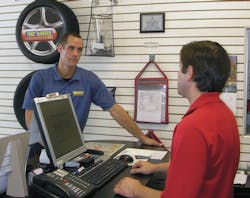6 key considerations before switching software
You most likely have some type of point-of-sale software system today, and it’s probably working OK for you. However, for a variety of reasons, you may be considering a change.
These six key considerations, from hosting to training, will make sure the change is a success.
1. Consider where to host the software.
There are two basic options. First, you can host the software on a computer in your business. This means you must purchase a computer capable of handling the demands of your entire business today and in the future. In addition, you take responsibility of ensuring your data is backed up every day. Also, you are responsible for the up-time of your system, the network infrastructure and the scheduling of software updates.
The second option is to have the software hosted by your software provider in a secure data center. This removes the hassle and expense of managing a business server, and it places the responsibility for uptime and data backups with your software professional; this method is called “cloud computing.” With it, you no longer worry about hardware malfunctions, replacing outdated equipment, or upgrading as your business requirements outgrow its capabilities.
Both options are viable. You need to weigh all the pros and cons including total cost of ownership.
2. Consider what to do with your existing data.
Dealers typically have lots of historical data on their existing system. The question is, should you convert it to the new system or not?
You can convert your data, but do you want to? Oftentimes, data is poorly constructed and was set up in a way that if you had it to do over again, you would do it differently. If that’s the case, don’t convert it. You will end up perpetuating the problem.
This is your chance to do it right. Keep the old system accessible for a period of time for those occasional history lookups and start with a clean system.
Also, no two software systems are designed alike. So the data mapping can be very sloppy, leaving you with a mess in your new system. Most companies will allow a data import to the basic master files via a spreadsheet. Take advantage of that for the files that have good data, such as a customer master file. In addition, make sure the new system has the ability to build inventories from standard databases such as tires.
[PAGEBREAK]
3. Consider creating a “must-have” list.
You need to create two lists, actually, your “must-have” and “nice-to-have” lists.
Put in writing the features and functions that are important and you absolutely must have in a new system. This will help you review any system that you look at.
Make it a living list and remember it’s OK to modify it as you go through the process.
By having this list, it will reduce that chance for confusion with one system vs. another. Complete a check-off list as you review each system.
For example, if inventory management is very important to you, list what functions of inventory management are “must-haves.” Then, make sure you see those functions and how they work when you get a demonstration of the software.
4. Consider the accounting function in your business system.
You need to think about “integrated” or “interfaced accounting.” There are two schools of thought on this topic. Do you want your accounting system to be an integrated part of the point-of-sale system or do you want to make sure the software interfaces to the popular accounting systems available on the market today, such as QuickBooks, Sage Peachtree, or MS Dynamics?
Both methods are acceptable. It’s a function of what you and your accountant are most comfortable with. Integrated is like the “eggs-in-one-basket” approach while Interfaced gives you some independence and flexibility.
5. Consider third party interfaces.
If you provide a lot of service work and sell parts, you should make sure your software interfaces to an on-line parts ordering system for labor and parts estimates.
You should have the ability to order tires electronically with your supplier right from the system. If you do a lot of national account business, it might be important to have the ability to process them right from your point-of-sale system. Make sure you have access to tire fitments, plus sizing, and basic tire information including pictures.
6. Consider all aspects of training.
When you upgrade to a new system, you have to learn how it works. It’s important to find out how easy the new system is to learn and to implement. Does it require you to spend a lot of time in training? What type of training? How much does it cost? If it requires a lot of training, you might wonder how easy or complicated it might be. Does the new system have on-line training videos? This helps once you have implemented the system and when you hire new employees; they can quickly become familiar with the new system on their own. Are there tools to help you build inventory and maintain prices?
By considering these six points before you make a purchasing decision, the change in software will go much more smoothly and you will be happier with your results — now and down the road. ■
Wayne Croswell is president and CEO of WECnology, a company which provides complimentary advice to independent tire dealers on all aspects of technology. Its technology expertise includes topics such as POS software, on-line reputation management, and mobile marketing. WECnology constantly evaluates technology providers looking for the “best-of-breed” in the industry. It works with dealers to understand their requirements and match them up to the best suited providers available. For more information, see www.wecnology.com, email [email protected] or call (603) 249-5530.
